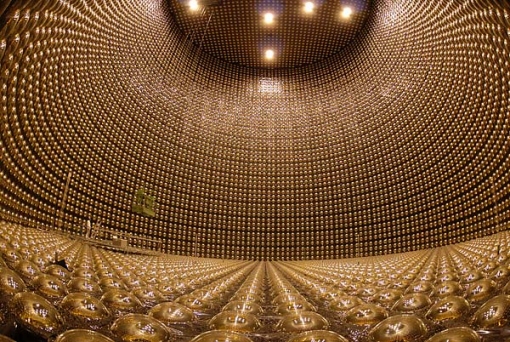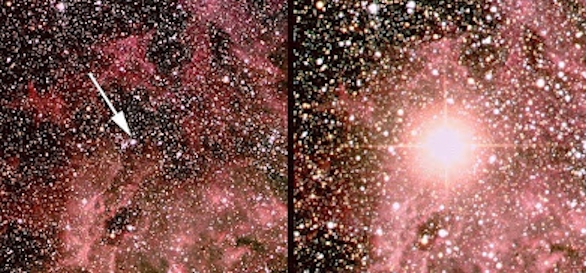

On February 23, 1987 the Japanese Neutrino detector at Kamioka mine detected 11 neutrinos within 10 seconds. The ordinary rate at which Kamiokande detected solar neutrinos was less than one a day. As you will recall from Neutrinos, Big Numbers, and Four Forces, ordinary matter is essentially invisible to neutrinos. Recall the football stadium model of the atom. The nucleus was a BB at the 50 meter line. A neutrino interaction may take place if a neutrino goes through the nucleus, but the nucleons are made of quarks. And the nucleons also look like empty space to neutrinos as the interaction range of the weak nuclear force is less than 1% of a proton radius. Tens of billions of neutrinos, originating in the sun's core, zip through your thumbnail every second. Yet a neutrino interaction with the matter in your body is likely to happen several times in a lifetime. The Kamiokande 2 detectors were triggered at more than 10,000 times the normal rate. Something rather significant had happened somewhere.

In the Large Magellanic Clouds, an irregular satellite galaxy of the Milky Way and about 10 million years ago, a star was born. We named it Sanduleak -69° 202 and when humans observed it, it was a blue supergiant -- spectral class B3Ia. The life histories of stars are determined at birth and the most significant factor is mass. The bulk of stellar evolution happens on the "main sequence" or the hydrogen fusing phase. Sanduleak -69° 202 began its life as a massive star -- weighing in at perhaps more than 50 solar masses. Such massive stars burn through their nuclear fuel rather quickly. A solar mass star will fuse hydrogen in its core for 10 billion years before leaving the main sequence to evolve into a red giant and then shrink to a white dwarf. Sanduleak -69° 202 burned through its hydrogen in 1/1000 of that time -- just ten million years. Then hydrogen fusion stopped, the massive gravity of the star weighed down upon the core heating it to 200 million °K and helium fusion began. A shell of hydrogen fusion continued outside the core and the star began to expand, probably becoming a red hypergiant or a luminous blue variable. This helium burning phase lasted only a million years. Carbon and Oxygen accumulated in the core and the next phase of carbon fusion began -- producing Neon, Sodium, Magnesium, and Aluminum. Helium fusion ignited outside the core and pushed the hydrogen fusing shell outward. At some point, the outer layers of the star were blown off into space as extremely intense solar wind.

The carbon fusion phase continued for only a 1000 years. Next, the core heats to more than 1 billion °K and the Neon fusing phase proeceeds, producing Oxygen and Magnesium. The Neon phase lasts less than 5 years. Then Oxygen begins fusing to Silicon, Sulfur, Argon, and Calcium for just a few months. Each other phase moves outward so that the core has an onion like structure of fusing shells. Finally Silicon fuses to Nickel for about one day. Then it's done!

Anglo-Australian Observatory
Each phase of fusion in the core has produced incredible amounts of energy to counteract the extremely massive star against gravitational collapse. Even though gravity is 1036 times weaker than the electomagnetic force, it cannot be balanced. Recall that there is no such thing as antigravity. The more mass you have, the greater the force. The second significant fact is that you can't get energy by fusing elements heavier than nickel and iron. Much heavier elements such as Uranium and Plutonium produce energy by fissioning, or splitting. It requires energy to fuse nickel to heavier elements. So there is nothing to hold the star up and it collapses. The core collapses much more quickly than the overlying shells that are still fusing -- in less than a second. The extreme gravity forces electrons and protons together until they collapse to neutron density. More than one solar mass is compressed to the size of a small city. In other words, all the empty space in the atoms is eliminated. The gravitational force completely dominates the electrical force. Each of the nucleons that collapse releases a neutrino or two or three before all is said and done. This neutrino flash occurs in a 1 to 10 second time period releasing -- get this -- 1046 Joules of energy! (A Watt is 1 Joule per second). This is similar to the amount of energy being produced by all of the stars in the visible universe combined. Or it equivalent to all of the energy our sun will produce in its entire 10 billion year life time. A Scientific American writer once characterized this as a number so big that it boggles even the well stretched imagination of astronomers. Our football field concept for visualizing big numbers comes up 31 zeroes short! We could imagine that our football stadium is a BB in another football stadium. And that the compound stadium is yet another BB in a yet bigger stadium. Then multiply by 10.
The collapsing star is still nearly transparent to the outrageously energetic neutrino flash, but somehow about 1% of the energy is transferred to the collapsing star which is more than enough to set off the supernova explosion. The star is large enough that it may take some hours for the explosion to rip through the star's layers and reach the surface. But 99% of the neutrinos raced out of the core at almost the speed of light and reached the Kamiokande Neutrino detector, 168,000 light years away, some hours before the first light arrived.
The type II or core collapse supernova is just one of three possible types. There hasn't been a supernova in our galaxy since 1604. But the Milky Way has an average of more than two supernovas a century. We are overdue!